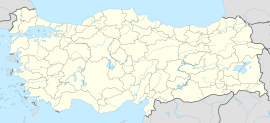Cevizli, Çukurca
Cevizli | |
|---|---|
| Coordinates: 37°20′00″N 43°43′01″E / 37.3333°N 43.717°E | |
| Country | Turkey |
| Province | Hakkâri |
| District | Çukurca |
| Population (2023)[1] | 59 |
| Time zone | UTC+3 (TRT) |
Cevizli (Kurdish: Gûzereş)[2] is a village in the Çukurca District in Hakkâri Province in Turkey.[3] The village is populated by Kurds of the Pinyanişî tribe and had a population of 59 in 2023.[1][4]
The four hamlets of Başak (Gundik), Güven (Pîrî), Sütlü (Xanê sê gund) and Yaylak (Mezrî) are attached to Cevizli. Güven and Sütlü are unpopulated.[2][3]
Cevizli was depopulated in the 1990s during the Kurdish–Turkish conflict.[5]
History
[edit]The village of Gûzereş was the only Kurdish village in the valley of Tkhuma prior to Sayfo, the current hamlets of Başak (Gundik), Sütlü (Xanê sê gund), and Yaylak (Mezrî) were Assyrian villages prior to World War I. They existed under the names Gundiktha, Khani and Mazra'a respectively.[6][7]
In 1698, a scribe in Qudshanis named Abraham was from the village of Mazra'a. Also, in 1785 a manuscript was copied by deacon Hajo of Gundiktha. Both are notable manuscript references to the villages.[6]
The village of Khani was established toward the end of the 19th century.[6]
The village of Mazra'a contained the famous church of Mar Pethiōn, while the village of Gundiktha had the church of Mar Khananya.[6]
Population
[edit]Population history of the village from 1965 to 2023:[8][1]
| Year | Pop. | ±% |
|---|---|---|
| 1965 | 692 | — |
| 1980 | 1,125 | +62.6% |
| 1990 | 985 | −12.4% |
| 2000 | 0 | −100.0% |
| 2011 | 42 | — |
| 2017 | 39 | −7.1% |
| 2022 | 36 | −7.7% |
| 2023 | 59 | +63.9% |
Pre-Assyrian Genocide Population
[edit]The village of Gûzereş itself was inhabited by 50 Kurdish families in 1914 according to Agha Petros.[7]
The following Assyrian populations are given by Bagder (1850)[9] and Cutts (1877)[10]
Gundiktha: 110 families (1850),[9] 150 families (1877)[10]
Mazra'a: 130 families (1850),[9] 180 families (1877)[10]
Khani: 50 families (1909)[6]
References
[edit]- ^ a b c "Population Of Municipalities, Villages And Quarters". TÜİK. Retrieved 10 May 2024.
- ^ a b "Çukurca köylerinin Kürtçe, Türkçe ve eski isimleri" (in Turkish). Archived from the original on 12 March 2023. Retrieved 17 December 2022.
- ^ a b "Türkiye Mülki İdare Bölümleri Envanteri". T.C. İçişleri Bakanlığı (in Turkish). Retrieved 19 December 2022.
- ^ Aşiretler raporu (in Turkish). Kaynak Yayınları. 1998. pp. 158–160.
- ^ Duran, Medeni (2006). Osmanlı'dan Şemdinli'ye JİTEM tarihi (in Turkish). Berçem Yayıncılık. p. 345.
- ^ a b c d e Wilmhurst, David (2000). The Ecclesiastical Organisation of the Church of the East, 1318-1913. Peeters Publishers. pp. 197–198.
- ^ a b Gaunt, David (2006). Massacres, Resistance, Protectors: Muslim-Christian Relations in Eastern Anatolia during World War I. Gorgias Press. p. 419. ISBN 9781593333010.
- ^ "Genel Nüfus Sayımları" (in Turkish). Retrieved 1 March 2023.
- ^ a b c Badger, George Percy (1852). The Nestorians and their rituals : with the narrative of a mission to Mesopotamia and Coordistan in 1842-1844, and of a late visit to those countries in 1850 ; also, researches into the present condition of the Syrian Jacobites, papal Syrians, and Chaldeans, and an inquiry into the religious tenets of the Yezeedees. p. 396.
- ^ a b c Cutts, Edward Lewes (1877). Christians under the crescent in Asia. p. 354.

